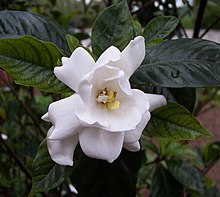Gardenia
| Gardenia | |
|---|---|
 |
|
| Gardenia jasminoides | |
| Scientific classification | |
| Kingdom: | Plantae |
| (unranked): | Angiosperms |
| (unranked): | Eudicots |
| (unranked): | Asterids |
| Order: | Gentianales |
| Family: | Rubiaceae |
| Subfamily: | Ixoroideae |
| Tribe: | Gardenieae |
| Genus: |
Gardenia J.Ellis |
| Species | |
|
See text. |
|
See text.
Gardenia is a genus of flowering plants in the coffee family, Rubiaceae, native to the tropical and subtropical regions of Africa, Asia, Madagascar and Pacific Islands.
The genus was named by Carl Linnaeus and John Ellis after Dr. Alexander Garden (1730-1791), a Scottish-born American naturalist.
They are evergreen shrubs and small trees growing to 1–15 metres (3.3–49.2 ft) tall. The leaves are opposite or in whorls of three or four, 5–50 centimetres (2.0–19.7 in) long and 3–25 centimetres (1.2–9.8 in) broad, dark green and glossy with a leathery texture. The flowers are solitary or in small clusters, white, or pale yellow, with a tubular-based corolla with 5-12 lobes (petals) from 5–12 centimetres (2.0–4.7 in) diameter. Flowering is from about mid-spring to mid-summer, and many species are strongly scented.
As of March 2014[update]The Plant List recognises 140 accepted species (including infraspecific names):
Gardenia plants are prized for the strong sweet scent of their flowers, which can be very large in size in some species.
Gardenia jasminoides (syn. G. grandiflora, G. Florida) is cultivated as a house plant. This species can be difficult to grow because it originated in warm humid tropical areas. It demands high humidity to thrive, and bright (not direct) light. It flourishes in acidic soils with good drainage and thrives on [68-74 F temperatures (20-23 C)] during the day and 60 F (15-16 C) in the evening. Potting soils developed especially for gardenias are available. G. jasminoides grows no larger than 18 inches in height and width when grown indoors. In climates where it can be grown outdoors, it can attain a height of 6 feet. If water touches the flowers, they will turn brown.
...
Wikipedia
